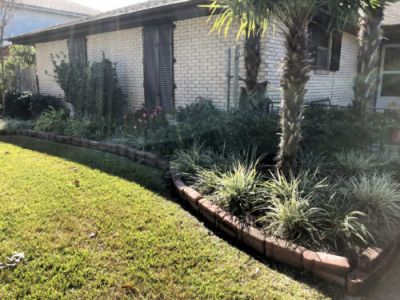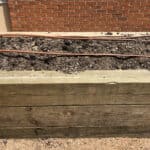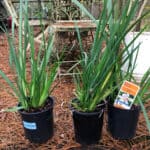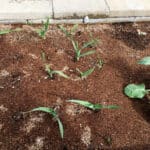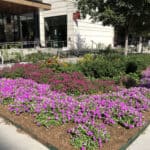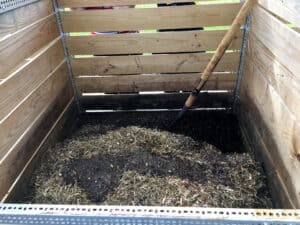(Image above: Well-planned garden beds of MGGNO Master Gardener John Beale class of 1998.)
Spring/Summer Garden Preparation
An attractive and productive garden starts with careful preparation. As the seasons change from spring to summer it’s a smart idea to start preparing existing or new gardens beds before planting flowers or vegetables. Get ideas from gardens you see around town or from garden magazines. Choose plants that you like, vegetable and herbs that you plan to eat or use. Make sure the plants are suitable for your area and are available at your local nurseries. See plant lists and ideas at the LSU AgCenter website.
Be sure to plan for what you can handle. It may be best to build a large garden in stages, i.e. design and plant one new garden in the front yard now, put in another segment or garden next fall. For bedding areas that are already in use, clean up by removing weeds, old roots, end of season annuals and any dead or diseased plants. Clear out any old roots or debris using a wide toothed rake.
(Images above: [left] Raised bed with drip irrigation; [left center] Place plants before planting; [right center] Garlic planting with compost and mulch at Federal City Garden, Algiers; [right] Mulched flower bed)
A soil test is recommended when starting a new garden bed or if you’ve had problems with growing plants in the past. A soil test can tell you the pH (if your soil is more acid or alkaline with 7 being neutral on a scale of 10-14 where one is acid and 14 is alkaline) of your soil. An ideal pH is slightly less than neutral for most plants about 6.0-6.5 pH but there are exceptions depending on the plant. The soil test results will tell you if your soil is in need of amendments, nutrients and what, if anything, is needed to improve it. Get a soil test kit and instructions from the LSU Agriculture Center. Once the results come back, find information on interpretation to see soil information or call your local extension service to speak to your county agent for help.
(Image right: Compost bin at Federal City Garden in Algiers)
It may not be necessary to do a soil test if you have had one in recent years, you can add and mix in generous amounts of organic matter to new and existing plant beds such as composted manure and or humus to hard clay soils and soils that are too sandy. Make your own compost by using a compost bin. Make your own or simply build up a mound in your yard. Find information on how to compost and compost design ideas on the LSU AgCenter website.
Weeds are an eyesore and they compete with desired plants for nutrients, water, and sunlight. Manage weeds by completely pulling them out of the soil with the roots intact or by using an herbicide. Use preemergent weed blocks such as Preen in planted flower beds on top of mulch and water in. Don’t use Preen when using desired seeds as Preen will prevent them from germinating. Always carefully read herbicide labels following directions. Weed seeds are distributed by birds, on your clothes, and by other animals. Stay on top of any weed problems by removing weeds as soon as you see them.
Turn the garden soil by digging down at least eight inches. Rake the soil smoothing it out. Add garden soil, topsoil, compost, or humus to raise the bed area to help with drainage. Before planting shrubs and flowers in the garden, be sure to add a complete fertilizer, liquid or timed released.
Vegetables are classified as one of the following:
- Light feeders: requiring 2-4 lb. of 8-8-8 fertilizer per 100-300 square feet
- Medium feeders: requiring 4-6 lb. of 8-8-8 fertilizer per 100-300 square feet
- Heavy feeders: requiring 6-8 lb. of 8-8-8 fertilizer per 100-300 square feet
See the Louisiana Vegetable Planting Guide, publication #1980 for more information on fertilizing vegetables.
Lay out plants at the appropriate distance apart before planting to see how they fit. Remember to use plants with similar needs. Check labels for plant requirements such as sun/shade and water requirements, etc. If possible, wet plants before transplanting them in your garden if they are very dry to help minimize plant shock. The top of the root ball of a plant should be planted even with the soil.
After prepping and planting your vegetable and/or flower garden, be sure to apply two to four inches of mulch on top of your planting to help keep plant roots cool, moist, and to manage weeds. Use dropped leaves and pine straw from your yard to mulch the top of your garden beds as a cheap alternative to purchased mulch.

By Karen Blackburn

